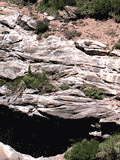The peri-Alpine Paleogene Red Molasse of southeastern France
I. Esparron syncline and Esclangon area (Alpes-de-Haute-Provence)
DOI:
https://doi.org/10.2110/carnets.2025.2511Keywords:
molasse, Rupelian, Chattian, Alps, FranceAbstract
The Paleogene succession of the Esparron syncline consists of three superimposed stratigraphic units, in ascending order: (1) a lacustrine-palustrine-dominated basal unit (BU) bearing channels filled by limestone breccias at base, (2) fluvial deposits of the lower Molasse Rouge Formation (MR1), and (3) well-rounded polygenic conglomerates, bearing Alpine "green rocks" and radiolarites overlain by red clays in the upper Molasse Rouge Formation (MR2).
Breccia deposits of the basal unit represent a multi-channeled torrential system generally sloping to the northeast. However, the regional extent and character of the BU is difficult to determine due to its truncation by the basal surface of MR1. Around the northwestern termination of the Esparron syncline the succession is complete and 200 m thick. Basal breccias of the BU pass upward to reddish fluvial overbank mudstones, then to grayish lacustrine-palustrine limestones, and back to reddish silty claystones. Field data suggest that this unit cannot be proximal deposits of the "Nummulitic foreland basin", but is younger, just predating deposition of the MR1, likely in the late Rupelian. These also cannot be proximal deposits of MR1, as formerly suggested. They constitute a fully distinct tectono-stratigraphic sequence whose deposition cannot be understood without a broad regional synthesis (in preparation).
Along the southern flank of the syncline, MR1 has a sheet geometry featuring amalgamated fluvial point bar deposits at the base, which are overlain by the deposits of a large fluvial fan prograding to the west. MR1 deposits abruptly pinch out along the northern flank of the syncline, and are interpreted as having filled a paleovalley that roughly matches the E-W orientation of the syncline.
South of the syncline, in the Esclangon and Hautes Duyes areas, the same succession is found but the meandering fluvial deposits of Esparron are lacking at the base of MR1. Here, MR1 deposits are represented by fluvial fan deposits prograding to the west, but have a more proximal character than at Esparron. In this area, the MR1unit is capped by the Molasse Grise (MG), which represents a flattening of the depositional profile after the progradation of the underlying fluvial fan.
Across the entire region, MR2 deposits are thin, and likely truncated by the main Digne thrust. They are deposited disconformably on top of either MR1 or directly on folded Mesozoic deposits, suggesting that erosion and tectonic activity occurred between deposition of MR1 and MR2. The occurrence of well-rounded pebbles of Alpine "green rocks" and radiolarites in the basal fluvial conglomerate of MR2 indicates that the system had a large watershed that encroached the inner Alps, probably during uplift of the latter.
In the Ainac area, the braided fluvial facies at the base of MR2 acquired a more distal character with channels filled by either conglomerates or a more sand-prone facies.
The vertical facies trend in MR1 and MR2 suggests that a low-gradient fluvial setting was followed by regional uplift responsible for the progradation of fluvial fans. The two stratigraphic units are therefore regarded as tectono-stratigraphic sequences, in response to changes in the Alpine stress regime. With unit 1 (BU), the Molasse Rouge is therefore composed of three independent sequences.
Finally, the ages of the MR1 and MR2 deposits are revised, both to Chattian and probably not extending into the Aquitanian, as previously reported for the MR2.
Geometric relationships suggest that the three continental Paleogene sequences record a changing depositional setting controlled by both active tectonics and intervening periods of quiescence in a time interval grossly bracketing the late Rupelian and the Chattian.

Downloads
Published
Issue
Section
License
Copyright (c) 2025 Carnets Geol.

This work is licensed under a Creative Commons Attribution-NonCommercial-ShareAlike 4.0 International License.

